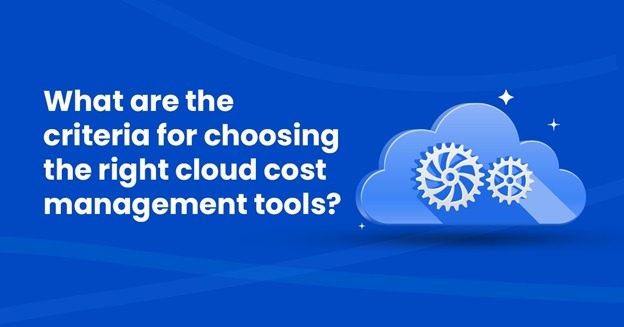In today’s digital age, cloud computing has become vital to an organization’s digital infrastructure. It allows businesses to access data and applications remotely, scale their operations quickly and easily, and access powerful tools at a fraction of the cost of traditional computing. However, with the increasing number of cloud-based applications and services, organizations must manage their cloud expenditure efficiently. This is where cloud cost management tools come in.
Cloud cost management tools allow organizations to monitor and control their cloud-based expenses. They are designed to help organizations identify where their cloud-based costs are coming from and how they can reduce them. With the right cloud cost management tool, organizations can maximize their cloud investments’ value while ensuring that their cloud costs remain within budget.
In this blog post, we’ll explore some of the criteria organizations should consider when choosing a cloud cost management tool. We’ll look at the key features for selecting a tool and tips on evaluating the potential tools. Finally, we’ll provide recommendations on the market’s best cloud cost management tools.
Why do you need a cloud cost management tool?
In today’s fast-paced and ever-evolving digital landscape, cloud computing is a critical component of most businesses’ operations. Cloud computing provides organizations with the ability to access vast amounts of computing power, storage, and software applications, enabling them to rapidly scale and meet their demands. However, one of the major drawbacks to cloud computing is that it can quickly become expensive if not managed properly. That’s why so many organizations are turning to cloud cost management tools to help them better manage their cloud usage and costs.
A cloud cost management tool is a software solution that helps organizations monitor, control, and optimize their cloud usage and costs. These tools provide organizations with visibility into their cloud spending and usage patterns, allowing them to identify wasteful or inefficient usage and make better-informed decisions about their cloud usage. Cloud cost management tools also provide organizations with the ability to set usage limits, track usage trends, and set budget alerts to ensure that their cloud usage remains within budget.
By utilizing a cloud cost management tool, organizations can gain the insights they need to make better decisions about their cloud usage. This can help organizations reduce their cloud costs, allowing them to stay within budget while still taking advantage of the scalability and flexibility of cloud computing. Furthermore, cloud cost management tools can help organizations identify and address potential security risks, helping to ensure that their cloud environment is not vulnerable to malicious attacks.
Overall, cloud cost management tools can be a valuable asset for organizations that are looking to better manage their cloud usage and costs. By utilizing these tools, organizations can gain visibility into their cloud usage and costs, allowing them to make better-informed decisions about their cloud usage and stay within budget.
What Should You Look for in a Cloud Cost Management Tool?
When selecting a cloud cost management tool, there are several key features to look out for. Here are some of the most important criteria to consider:
- Automation: Automation is key to reducing the manual effort required to manage cloud costs. Look for a cloud cost management tool that offers automated processes, such as cost allocation rules, billing alerts, and cost optimization.
- Accuracy: Look for a cloud cost management tool that offers accurate and up-to-date data on cloud usage and costs. This will ensure that you have the most accurate view of your cloud spending.
- Visibility: It’s important to have visibility into your cloud costs and usage. Look for a cloud cost management tool that offers detailed reporting and analytics.
- Cost Optimization: Look for a cloud cost management tool that offers features for optimizing cloud costs, such as rightsizing resources, eliminating unused resources, and setting budget alerts.
- Easy to Use: Look for a cloud cost management tool that is easy to use and intuitive. This will ensure that your team can quickly get up and running with the tool.
- Integrations: Look for a cloud cost management tool that offers integrations with other software and services. This will ensure that you can easily connect the tool to other tools in your workflow.
- Security: Security is a critical factor when it comes to managing cloud costs. Look for a cloud cost management tool that offers robust security measures, such as multi-factor authentication and data encryption.
- Support: Look for a cloud cost management tool that offers robust customer support, such as access to a knowledge base, FAQs, and customer service representatives.
- Scalability: As your cloud usage increases, you’ll need a cloud cost management tool that can scale with you. Look for a tool that can grow with your organization.
- Pricing: Look for a cloud cost management tool that offers competitive pricing. Compare pricing plans to find the best option for your needs.
Choosing the right cloud cost management tool can be a challenge. By considering these top 10 criteria, you can ensure that you’re selecting the best tool for your organization’s needs.
Conclusion
Cloud cost management tools are essential for optimizing cloud-based expenses. When selecting a cloud cost management tool, it’s important to consider a range of criteria, such as cost tracking and analysis, automation, scalability, flexibility, and security. Additionally, it’s important to research the market, read reviews, try out the tool, get a demo, and compare prices.
We hope this blog post has given you insight into the criteria to consider when choosing a cloud cost management tool. If you’re looking for a cloud cost management tool, we recommend looking at nOps.

